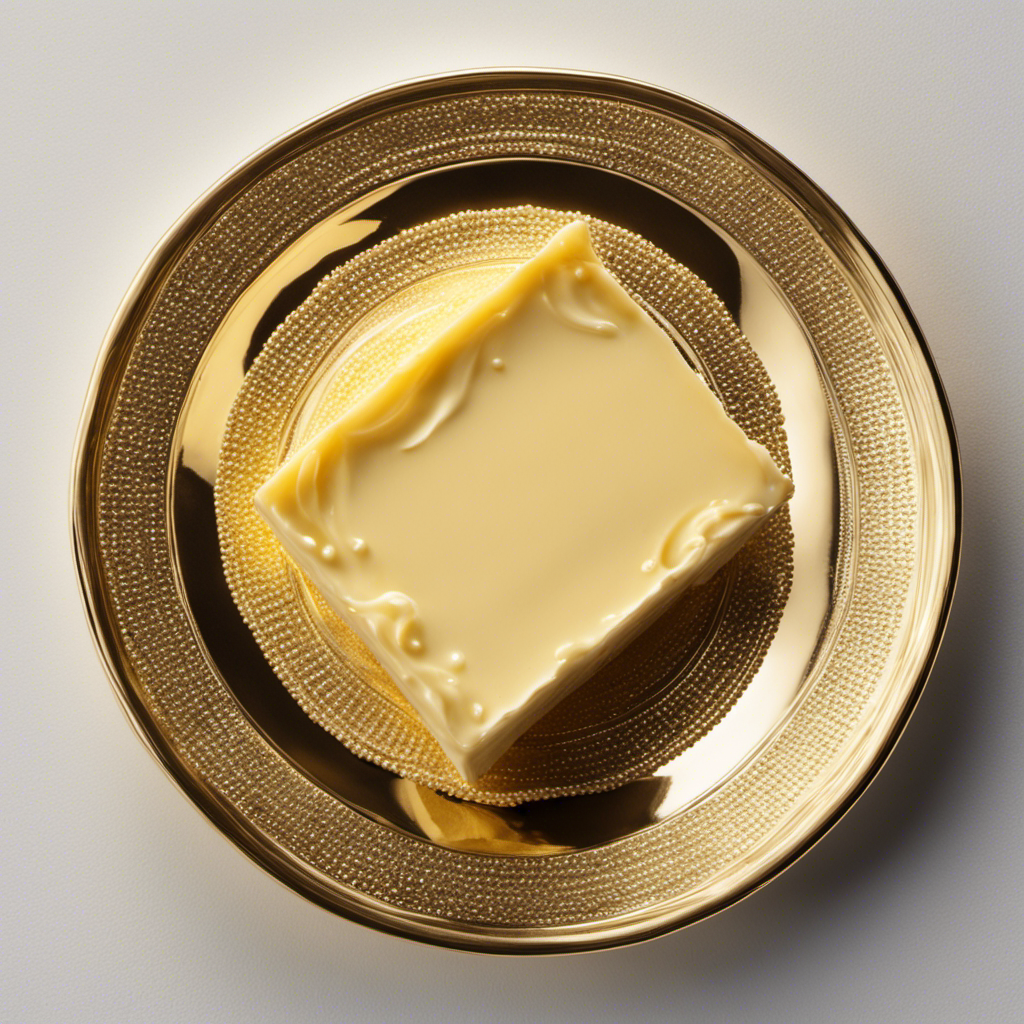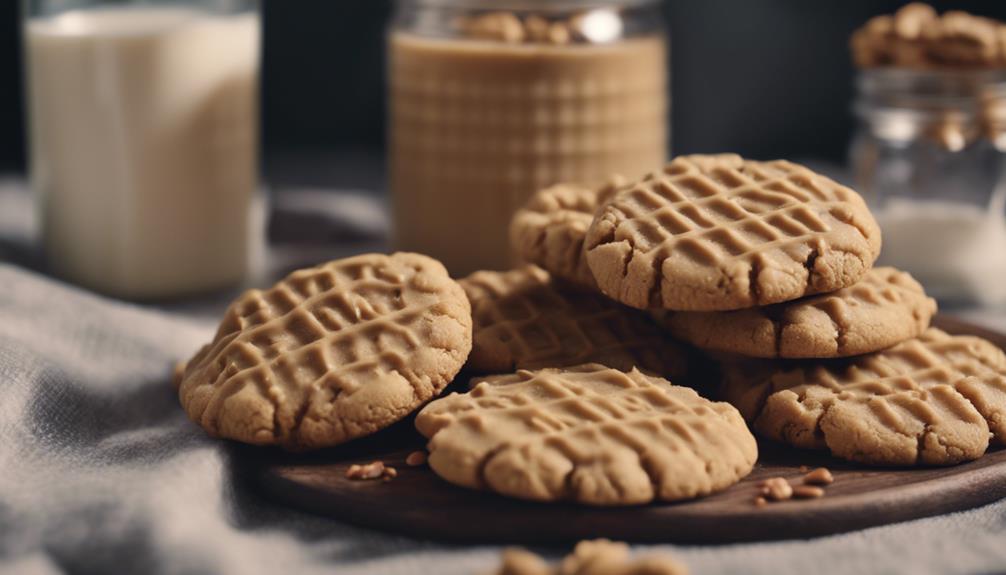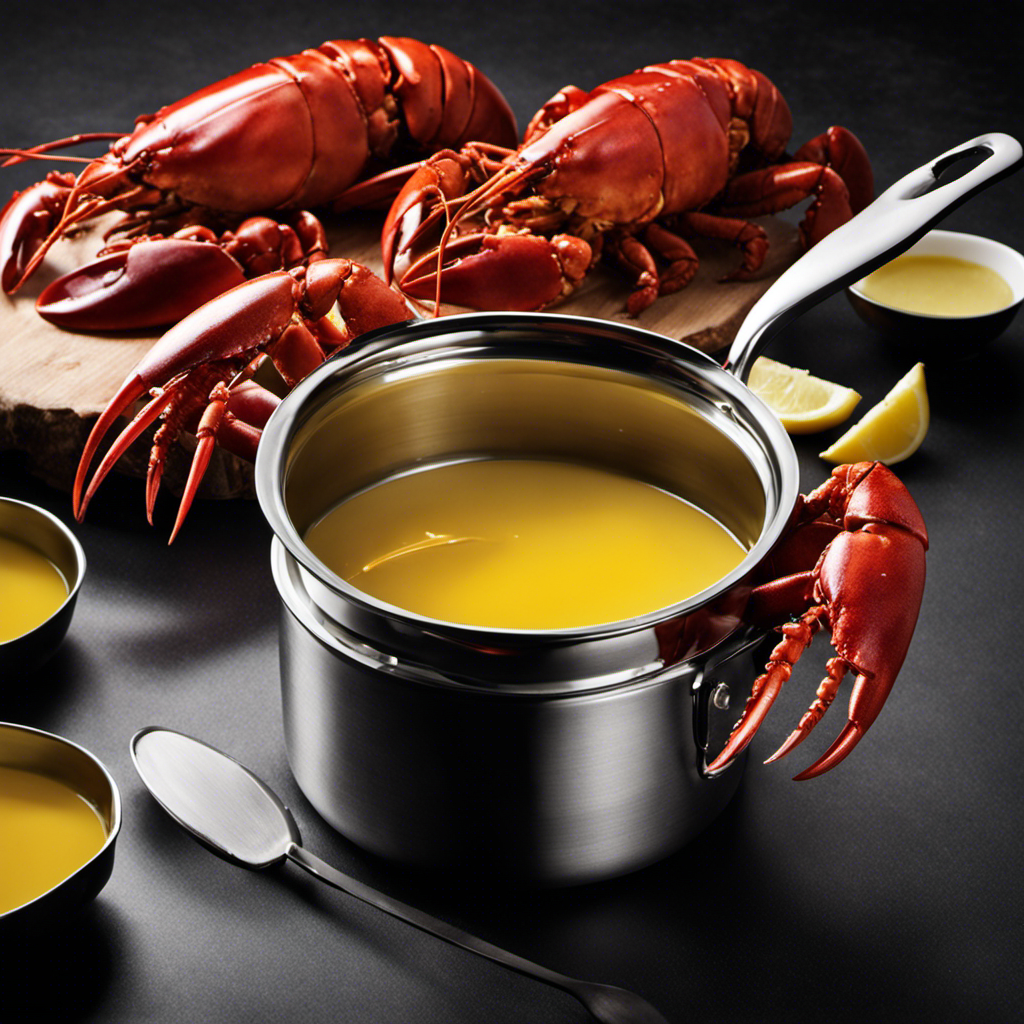As someone who loves cooking, I have frequently thought about the ideal temperature for room temperature butter. This intriguing subject delves into the nuances of temperature and the exact science of properly softening butter.
In this article, we will explore the ideal temperature range for room temperature butter and uncover the secrets to achieving that perfect consistency.
So, grab your apron and let’s delve into the world of buttery bliss!
Key Takeaways
- Room temperature butter is essential for achieving the desired texture and consistency.
- The ideal temperature range for room temperature butter is typically between 65 and 70 degrees Fahrenheit.
- Room temperature butter is softer and easier to cream with sugar, resulting in a lighter texture in baked goods.
- Softening butter to room temperature is crucial for many baking recipes.
Why Room Temperature Matters for Butter
If you want your butter to spread easily, you should keep it at room temperature. Room temperature butter storage is essential for achieving the desired texture and consistency.
When butter is too cold, it becomes hard and difficult to spread, leading to frustration and uneven distribution. On the other hand, if butter is too warm, it can become greasy and lose its shape.
By storing butter at room temperature, around 68 to 72 degrees Fahrenheit (20 to 22 degrees Celsius), it becomes soft and pliable, making it easy to spread on bread or toast.
Room temperature also affects the quality of butter. When stored at the appropriate temperature, butter retains its flavor and aroma, enhancing the overall taste of dishes it is used in.
The Ideal Temperature Range for Room Temperature Butter
The ideal range for softened butter is typically between 65 and 70 degrees Fahrenheit. This temperature allows the butter to be pliable and spreadable, making it easier to incorporate into recipes.
Room temperature butter is preferred in many baking and cooking applications because it mixes more evenly with other ingredients, resulting in a smoother texture and better overall consistency.
Cold butter, on the other hand, is often used in recipes that require a flaky texture, such as pastry dough or pie crusts. When using cold butter, the fat remains solid during the baking process, creating small pockets of air that contribute to a light and flaky end result.
However, it is important to note that the ideal butter temperature can vary depending on the specific recipe and desired outcome.
Understanding the Science Behind Room Temperature Butter
To understand why room temperature butter is preferred for baking, you should know the science behind its pliability and ability to mix evenly with other ingredients.
Room temperature butter benefits baking because it is softer and easier to cream with sugar, resulting in a lighter and more tender texture in baked goods. When butter is at room temperature, its fat molecules are partially melted, allowing them to incorporate more air during the creaming process. This air trapped in the butter helps create a light and fluffy texture in cakes and cookies.
Additionally, room temperature butter blends more evenly with other ingredients, ensuring a smooth and homogeneous batter or dough.
To store butter at room temperature, keep it in a covered butter dish or a butter bell to protect it from light and air, which can cause it to spoil.
How to Soften Butter to Room Temperature
Here’s a quick tip on softening your butter to achieve the perfect texture for baking.
Softening butter to room temperature is crucial for many baking recipes as it helps the fat incorporate evenly into the batter, resulting in a tender and moist baked good.
There are a few techniques you can use to soften butter effectively. One method is to leave the butter at room temperature for about 30 minutes, depending on the ambient temperature. Alternatively, you can microwave the butter on low power for short intervals, checking regularly to prevent it from melting. Another option is to grate cold butter using a cheese grater, which helps it soften quickly.
Remember to store room temperature butter properly by keeping it in an airtight container or wrapped in wax paper to prevent it from absorbing any odors from the fridge.
Common Mistakes When Softening Butter
When it comes to melting time, it is crucial to understand that butter’s melting point is around 90-95°F (32-35°C). This means that it can melt relatively quickly, especially in warm environments.
However, achieving the proper butter consistency is equally important in various recipes, as it can affect the texture and overall outcome of the dish.
Therefore, it is essential to pay attention to both the speed at which butter melts and the desired consistency for optimal results.
Butter Melting Time
If you want your butter to melt quickly, microwave it for a few seconds. However, it’s important to note that the melting point of butter varies depending on its temperature.
Room temperature butter, typically around 68°F (20°C), has a lower melting point compared to cold butter straight from the refrigerator. This is because the fats in butter start to soften and become more liquid-like as they warm up.
Here are some key differences between room temperature butter and cold butter when it comes to melting time:
- Room temperature butter melts faster due to its lower melting point.
- Cold butter takes longer to melt because it needs more time to warm up.
Additionally, there are differences in how room temperature butter and cold butter behave in various culinary applications:
- Room temperature butter spreads more easily on bread and other foods.
- Cold butter is firmer and holds its shape better when used in baking.
- Melting cold butter can alter the texture and consistency of certain recipes.
Understanding these differences can help you achieve the desired results in your cooking and baking endeavors.
Proper Butter Consistency
Achieving the proper consistency of butter is essential for successful cooking and baking. Softening the butter to the right temperature allows it to blend smoothly with other ingredients, ensuring a uniform texture and better incorporation of flavors.
There are various methods to soften butter, depending on the time available. The most common method is leaving it at room temperature for around 30 minutes, but this can vary depending on the ambient temperature. Alternatively, you can soften butter in the microwave by heating it in short bursts, being careful not to melt it completely. Another option is using a grater to shred cold butter, which increases its surface area and helps it soften faster.
Proper butter storage is also crucial for maintaining the right consistency. It is best kept in an airtight container or wrapped tightly in wax paper to prevent it from absorbing any unwanted odors or flavors from the fridge.
Using Room Temperature Butter in Baking and Cooking
When it comes to cooking, butter consistency plays a crucial role in achieving the desired results. Understanding the benefits of using room temperature butter can greatly enhance the taste and texture of your dishes.
In this discussion, I will delve into the importance of butter consistency for cooking and the specific advantages of using room temperature butter in your culinary endeavors.
Butter Consistency for Cooking
To achieve the desired consistency for cooking, you’ll want room temperature butter. This is because room temperature butter is easier to work with and incorporates better into recipes compared to cold butter.
When it comes to butter consistency for cooking, here are some key points to keep in mind:
- Butter melting: Room temperature butter melts faster and more evenly when added to hot pans or used in recipes that require melting the butter.
- Butter softening: Softened butter is crucial for creaming with sugar, as it creates air pockets that help in achieving a light and fluffy texture in baked goods.
- Avoid microwave: While it may be tempting to soften butter quickly using a microwave, it can lead to uneven softening or melting, which can affect the final outcome of your recipe.
- Time for softening: It usually takes around 30-60 minutes for butter to reach room temperature, depending on the ambient temperature.
- Test for readiness: To check if butter is at room temperature, gently press your finger against the butter. It should give a slight indentation without being too soft or melted.
Benefits of Room Temperature Butter
By keeping your butter at a warmer state, you’ll discover that it spreads more easily on bread and other baked goods. But what if you don’t have room temperature butter on hand? No worries, there are alternatives you can use in your recipes.
One option is to use vegetable oil as a substitute for room temperature butter. It will provide a similar texture and moisture to your baked goods. Another alternative is using avocado. Avocado has a creamy consistency and a mild flavor that pairs well with many recipes. Coconut oil is also a great option as it adds a subtle tropical flavor to your dishes.
Using room temperature butter in recipes has numerous benefits. It incorporates more easily into batters and doughs, resulting in a smoother texture. It also helps with the creaming process, allowing for better aeration and lighter baked goods. Additionally, room temperature butter helps to distribute flavor more evenly throughout the recipe. So next time you’re baking, give room temperature butter a try for a better culinary experience.
| Room Temperature Butter Alternatives | Benefits of Using Room Temperature Butter in Recipes |
|---|---|
| Vegetable oil | Smoother texture, easier incorporation |
| Avocado | Creamy consistency, mild flavor |
| Coconut oil | Subtle tropical flavor, better distribution |
Frequently Asked Questions
Can I Microwave Butter to Quickly Soften It to Room Temperature?
Yes, you can microwave butter to quickly soften it. However, there are alternative methods to soften butter such as leaving it at room temperature or using a grater.
How Long Does It Take for Butter to Reach Room Temperature Naturally?
Room temperature butter is typically around 68-72°F (20-22°C). To maintain its freshness, store it in an airtight container at a cool temperature. If you need to soften butter quickly without heat, try grating it or using a rolling pin.
Can I Use Melted Butter as a Substitute for Room Temperature Butter in Baking?
I once tried using melted butter instead of room temperature butter in a cookie recipe, and the cookies turned out flat and greasy. To quickly soften butter for baking, I recommend cutting it into small pieces and microwaving it in short intervals.
Is It Safe to Leave Butter at Room Temperature for an Extended Period of Time?
Leaving butter at room temperature for an extended period is safe as long as it is stored properly. However, it may affect the quality and flavor due to potential oxidation and rancidity.
Can I Speed up the Process of Softening Butter by Cutting It Into Smaller Pieces?
Yes, cutting butter into smaller pieces can speed up the softening process. However, room temperature butter can affect the texture of baked goods, and it should be stored properly to avoid spoilage.
Conclusion
In conclusion, room temperature butter is a crucial ingredient in baking and cooking. It enhances the texture and flavor of our favorite treats. By understanding the ideal temperature range and science behind it, we can ensure perfect results every time.
Softening butter to room temperature can be easily achieved with a few simple techniques. Avoid common mistakes that can ruin your recipes.
So, start savoring the smooth, spreadable, and sumptuous satisfaction of room temperature butter in your culinary creations!










